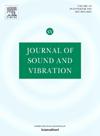General theory for separate scanning of vertical and torsional modal properties of thin-walled girders by a moving four-wheel test vehicle
IF 4.3
2区 工程技术
Q1 ACOUSTICS
引用次数: 0
Abstract
The novelty of this paper is to make full use of the four wheels’ signals of a scanning vehicle in detecting the frequencies, damping ratios, and mode shapes of the bridge. To offer a theoretical basis, closed-form solutions are derived for the responses of a damped mono-symmetric beam. Then, the wheel-bridge contact responses are calculated from those of the vehicle to eliminate the vehicle frequencies’ masking effect. Further, for rigid cross sections, the vertical and torsional-flexural responses of the bridge are separated from those of the left and right wheels. The Gabor transform is employed to convert the responses from time to time-frequency domain. Of interest is the dual role played by the front and rear wheels via their spatial correlation. First, for the wheels acting at the same location, but different instants (due to their time lag), the bridge damping ratio is determined as a measure of the decay in response. Second, for the wheels acting at the same instant, but different locations (spanned by vehicle length), the amplitude ratio of two adjacent modal points is used in recovering the mode shapes that are free of damping distortion. The present method is validated by the finite element simulation with the conclusions: (1) the vertical and torsional frequencies, damping ratios, and mode shapes of the bridge can be successfully identified; (2) the theory is robust with regard to bridge damping, vehicle suspension damping, vehicle speed, vehicle’s eccentricity; and (3) the results identified of the modal parameters are acceptable, even in face of pavement roughness and environment noise if the bridge vibration can be properly elevated.
移动四轮试验车分离扫描薄壁梁竖向和扭转模态特性的一般理论
本文的新颖之处在于充分利用扫描车的四个车轮信号来检测桥梁的频率、阻尼比和振型。为了提供理论依据,推导了单对称阻尼梁响应的封闭解。然后,根据车辆的接触响应计算轮桥接触响应,消除车辆频率的掩蔽效应。此外,对于刚性截面,桥梁的垂直和扭转弯曲响应与左右车轮的响应是分开的。利用Gabor变换将响应从时域转换为时频域。有趣的是前轮和后轮通过它们的空间相关性所扮演的双重角色。首先,对于作用于同一位置但不同时刻(由于它们的时滞)的车轮,桥梁阻尼比被确定为响应衰减的度量。其次,对于在同一时刻但不同位置(由车辆长度跨越)的车轮,使用相邻两个模态点的振幅比来恢复无阻尼畸变的模态振型。通过有限元仿真验证了该方法的有效性,得出如下结论:(1)该方法能够较好地识别桥梁的垂向频率、扭转频率、阻尼比和振型;(2)该理论对桥梁阻尼、车辆悬架阻尼、车速、车辆偏心均具有鲁棒性;(3)如果能适当提升桥梁振动,即使面对路面粗糙度和环境噪声,模态参数的辨识结果也是可以接受的。
本文章由计算机程序翻译,如有差异,请以英文原文为准。
求助全文
约1分钟内获得全文
求助全文
来源期刊

Journal of Sound and Vibration
工程技术-工程:机械
CiteScore
9.10
自引率
10.60%
发文量
551
审稿时长
69 days
期刊介绍:
The Journal of Sound and Vibration (JSV) is an independent journal devoted to the prompt publication of original papers, both theoretical and experimental, that provide new information on any aspect of sound or vibration. There is an emphasis on fundamental work that has potential for practical application.
JSV was founded and operates on the premise that the subject of sound and vibration requires a journal that publishes papers of a high technical standard across the various subdisciplines, thus facilitating awareness of techniques and discoveries in one area that may be applicable in others.
 求助内容:
求助内容: 应助结果提醒方式:
应助结果提醒方式:


